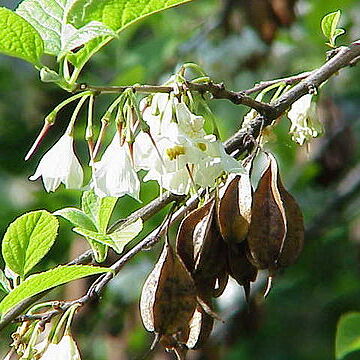Shrubs or trees, deciduous [evergreen], hairs stellate [scales]. Leaves alternate, simple; stipules absent; petiole present; blade margins serrate or entire, rarely also lobed. Inflorescences false-terminal and/or axillary racemes or panicles, sometimes solitary flowers. Flowers bisexual [plants gynodioecious]; perianth and androecium perigynous to epigynous; hypanthium adnate to ovary wall at various levels; sepals (2-)4-5(-9) [absent], distinct or connate, sometimes forming tube with or without minute apical teeth; petals 4-5(-8), connate proximally; stamens usually 2(-4) times [equaling] number of corolla lobes, adnate to corolla at base only or to 1/2 length of corolla, uniseriate in appearance; anthers dehiscent by longitudinal slits; pistils 1, 2-4[-5]-carpellate; ovary partly or completely inferior, proximally 2-4[-5]-septate, 1-locular by distal attenuation of septa; placentation axile [near basal]; ovules anatropous, uni-or bitegmic, tenuinucellate; styles 1, simple [3-parted]; stigmas 1, terminal, truncate or minutely 2-4[-5]-lobed. Fruits capsular, dehiscence loculicidal, or nutlike (dry and indehiscent), sometimes winged, [drupaceous]. Seeds 1-4[-ca. 50], brown, ellipsoid to globose or fusiform [flat, winged]; embryo straight or slightly curved; endosperm copious, cellular, oily.
Stamens equal and alternate with or double the number of the corolla-lobes, adnate to the corolla-tube or rarely free; anthers 2-celled, opening lengthwise
Ovary superior to inferior, 1-5-celled; style slender, 3-5-lobed; ovules 1 to many in each cell, axile, anatropous
Calyx tubular, more or less adnate to the ovary; lobes or teeth valvate or open
Corolla gamopetalous or rarely of free petals, lobes 4-7, valvate or imbricate
Flowers actinomorphic, hermaphrodite, racemose, axillary or terminal
Seed with copious endosperm and straight or slightly curved embryo
Trees and shrubs, often with stellate or lepidote indumentum
Fruit drupaceous or capsular, calyx persistent
Leaves alternate, stipules absent

